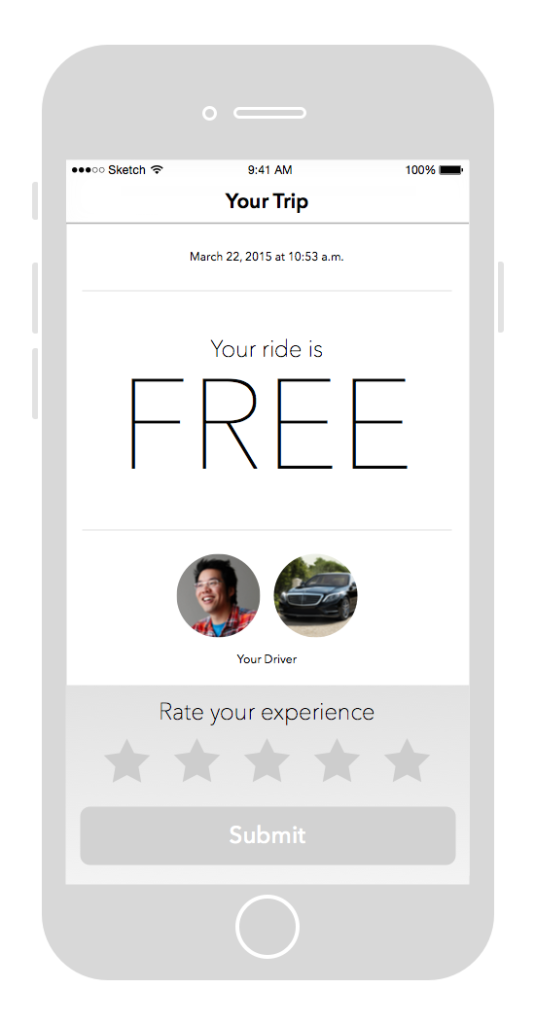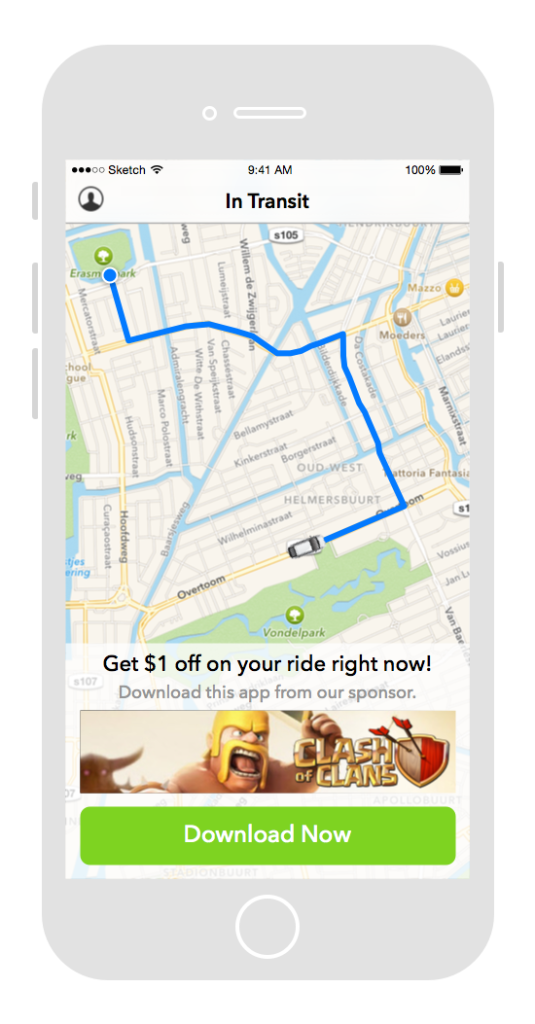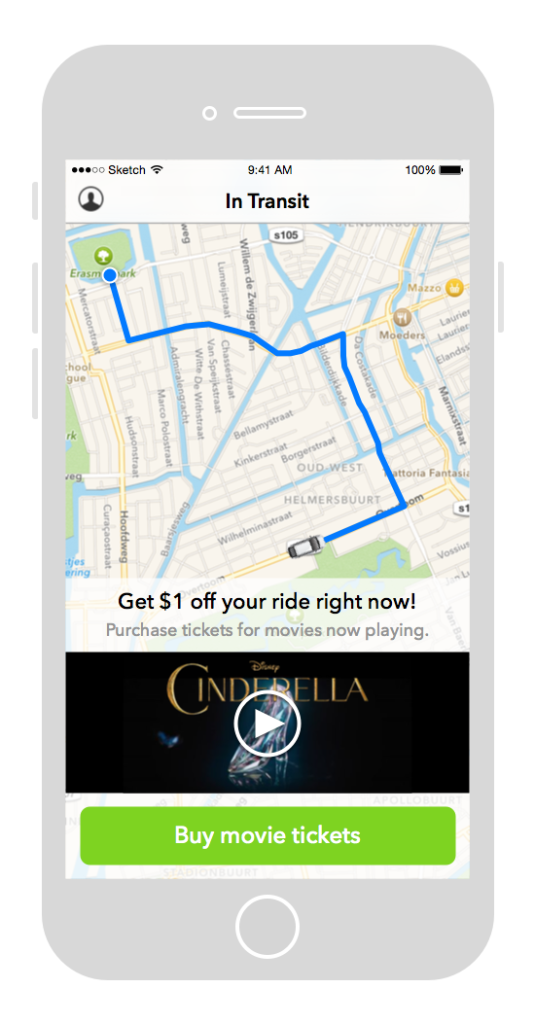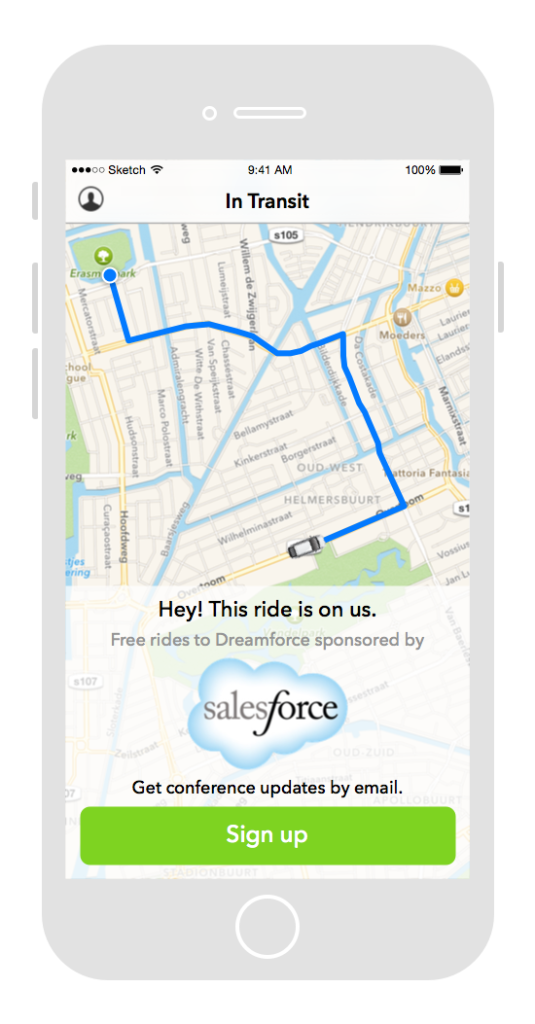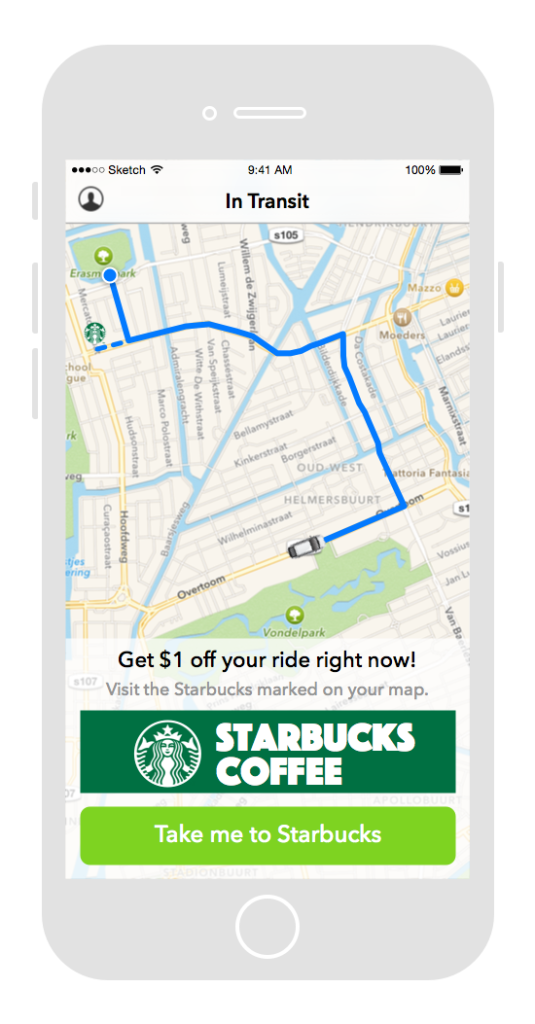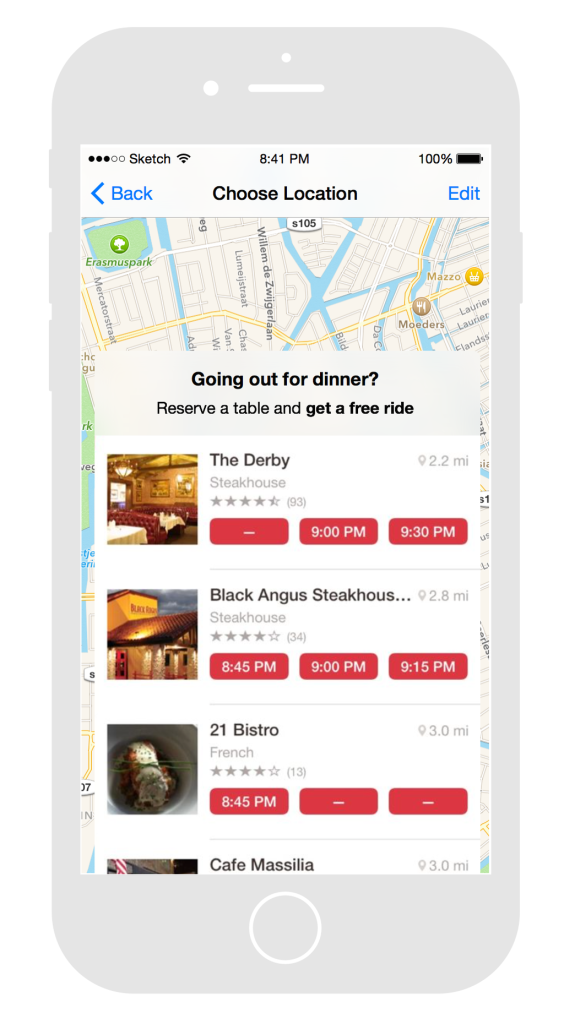This is what free, ad-supported Uber rides might look like. Mockups, economics, and analysis.
Cheaper and cheaper rides
Free, ad-supported Uber rides are inevitable, and if Uber doesn’t do them, a different competitor – perhaps Google! – will do it. It would be the next step in the industry’s trajectory towards lowering prices. Uber started in the high-end of the market, as “everyone’s private driver” which emphasized quality, but the early pricing was out of range for most. Dropping prices will increase demand, grow the market, and nothing will do that faster than going free.
Starting with UberX and now UberPool, each tier of service has dropped the price, tapping into more and more latent demand. Today, the figures are staggering – in San Francisco, Uber’s revenue is 3X bigger than the city’s entire taxi industry. Worldwide, the company now does 1 million rides per day and is adding 50,000 new drivers per month. Not bad at all. I wrote a tweet about this concept a few weeks ago and wanted to expand more on this topic.
Free!
The next step is free. Lowering prices drive all sorts of goodness- more rides, busier drivers, shorter wait times – all which powers the company’s network effects. So how would you push the prices even lower than UberPool?
Well, here’s a crazy idea:
UberZero. A free, ad-supported tier of service that’s cheaper than UberPool and UberX.
That’s right, ads. I think it can be done well. And no, I don’t mean the cheesy in-taxi TVs that play ads nonstop, because those are broken for a variety of reasons I’ll cover. Instead, my proposal would be to put the ad units on your smartphone, in the dead time while waiting for your car and when you’re on your ride. And then to connect these ads with the big existing markets for app installs, lead generation, video ads, and local ads.
After all, advertisers are already comfortable paying a couple bucks for a variety of direct response actions from users. Individually, or together, you could imagine the above budgets making a big dent into the price of a single ride. In some cases, it might just be a discount of $1 or $2 off. In other cases, you might make the ride completely free.
Mockups for four potential ad units
Here’s four potential ad units that might work. These mockups were done in collaboration with the talented Chris Liu (@machinehuman), who’s done UX at Mercedes Benz, Alexa/A9, and IMVU. It was fun to throw together a couple designs.
Without further adieu, some of the concepts:
1) App Installs
The first and most obvious opportunity would be to tap into the ecosystem of paid app installs. Most of the $10B+ market for mobile ads is from driving app installs.
The user experience would be something like this- today, right after you book a ride, you often just sit there, staring at your phone, wondering how many minutes it takes for an Uber to travel a few blocks in San Francisco. Instead of just twiddling your thumbs waiting, how about getting a buck or two off your ride just from downloading and playing with an app?
Or similarly, imagine your current in-car experience. I often get into an Uber, pull out my phone, and do a little email during the ride. It would be easy to simply redirect my attention to an app, or a video ad, or some other activity that creates value for both myself and an advertiser.
It might look something like this:
As mentioned earlier, app developers are often paying $3-10 per install, especially in the games and commerce categories. This is a meaningful % when UberPool currently lets you go anywhere in San Francisco for $7 flat fee.
The biggest problem with this is that this is an incentivized install, which performs worse and Apple doesn’t like it. The plus side is that the folks who are really spending money in this area direct marketing-oriented and will back out the proper Cost-Per-Install to bid given all of that. As for Apple’s dislike of incentivized installs, you could certainly combine it with other ad units, and make the install a completely optional thing, which brings us to the next idea…
2) Video ads
One of the most compelling new ad formats for mobile is video, which are commanding high rates, especially when combined with a call to action to install an app. This is one of the many reasons why ad-supported companies like Twitter and Facebook are doubling down on in-stream videos.
So while you wait for your car to arrive, or once you get into the car, just watch a short clip that does a full-screen takeover of your phone. Then after you watch, the ad presents an optional action to download the app, which is a double dip on value. This packages both a brand ad with some a direct response ad unit, making for a powerful combination.
In Snapchat’s early tests on video advertising, Adweek and others have reported they are asking $750k, equivalent to a $100 CPM to participate. There’s no reason why Uber wouldn’t be able to command similar rates, especially for endemic advertisers in travel, shopping, and local.
It might look something like this:
The key problem here would be to provide context and targeting. A classic TV ad against a show like, say, Oprah, provides both context, targeting, and a brand halo effect. An ad to an anonymous passenger isn’t compelling until you know a little bit more about them.
This begs the question, what do we know about a passenger? What would make sense from a targeting standpoint? Targeting is interesting because it’s an anonymous segment of people, which you could make off a number of interesting values:
- Name
- Contact info (email/phone)
- Location
- Where they’re coming from and where they’re going
- Work or personal credit card
Of course from a targeting perspective, you’d never pass on the personally-identifiable information to an advertiser, unless there was opt-in (more on that later!). But how compelling would it be to for example target people in a segment like the following:
- Passengers heading to a movie theater
- Passengers coming from SFO airport, heading to SOMA
- Passengers with email addresses like @google.com and @fb.com
- Passengers traveling in a group of 2+ going out on a Friday night
- Passengers heading home from work, or vice versa
- Passengers heading to the Dreamforce conference
- … and many more combinations
Now ask yourself, who else is able to deliver targeting ad inventory like this? There’s a very short list of companies that could even contemplate it. Of course it’ll be up to Uber as well as passengers to decide whether or not this kind of targeting criteria can be aggregated anonymously for ad targeting, but history has shown that ad targeting options tend to increase rather than decrease over time.
If you found the examples above compelling, imagine an instant rebate on your ride that relied on opt-in from the passenger to share this contact information directly. There’s a whole world of leadgen that’s willing to pay big bucks for accurate contact information for people who are in the market for targeted services and products.
3) Lead gen, especially for SaaS/B2B
I find leadgen an especially intriguing possibility because it’s commonplace for advertisers to pay something like $10 for an email address. For a SaaS/B2B advertiser, that number is even higher, as much as $30-50 in some cases. And if you’re talking about getting a credit card alongside an app install, that might be as high as $200 or more.
Of course you could never pass along a passenger’s contact info + credit card number without their consent. But what if you made it frictionless to consent? Then that previous list of attributes could all be sent in a series of confirmations: Name, contact info, payment information, etc.
At the heart of this is the fact that segmentation/targeting makes some audiences much more valuable than another. Today, a service like Uber charges a C-level executive the same price as the Average Joe. Imagine if you could have a leadgen campaign where an advertiser decides that someone with a “name@google.com” address is pretty valuable given that they’re a Google employee. Or perhaps it’s interesting to know that they are coming from a Salesforce conference.
You might provide a call to action like this:
This would make obvious sense for the high stakes world of SaaS/B2B leadgen, but it might also make sense to target a wide consumer base, especially around commerce. For example, targeting travelers who are arriving from the airport, to target them with highly personalized hotel/tour offers. Or targeting hardcore movie or concert-goers for their next night out.
Similar to the video ad scenario, the targeting capabilities would be key. Targeting based on location and context is key. And as I think about this, the most compelling part of the whole thing is that Uber/Lyft have data and context that is unique in the industry. They know where you are going, and where you are coming from, and enable you to go from Point A to Point B.
You know who else is like this and has created the most profitable and targeted advertising ever? Google, of course.
Google’s superpower is the Power of Redirection. When you search for something, Google can understand that intent and gently redirect you to the right place. Sometimes this is a destination that they deem relevant based on their algorithms, but sometimes, they just take you somewhere that’s paying them a bunch of money. This superpower is very valuable.
4) The Power of Redirection for local ads
Uber also has the redirection superpower, albeit in a different flavor. Similar to Google, when you plot a destination, there’s intent built into that. All the examples I’ve used previously indicate this- heading to Facebook’s HQ means something. Leaving from SFO means something. Heading to the 49ers stadium on a Sunday means something. And it would be easy for Uber to take you to your destination, but maybe they can suggest somewhere else to go, or perhaps they can suggest a complimentary product/service.
And using the analogy of organic versus paid search, perhaps there are organic destinations and there’s also paid destinations. In the case where a ride can be redirected to a paid destination, then Uber can literally, actually drive foot traffic. Pretty amazing!
For a trivial example, you might imagine something like this, that redirects you to a nearby Starbucks as a detour on your ride:
(The second mockup that bundles in restaurant reservations was sent in by Marc Köhlbrugge, founder of BetaList – thanks!)
You could imagine a clear application for travelers of course. Heading to the W Hotel? Why don’t you try an Aloft hotel and get $X off your stay. Think about how compelling this is compared to other forms of getting local foot traffic. Billboards? Radio? Well, in this case you can literally get someone to your footstep.
I think this could be fundamentally a new market, although it would make sense to tie this back to the $4.5B mobile/local ad market. Or you could tie it back to the unit economics of something like pay-per-call, where local vendors are willing to buy a live phone call with a customer for $10. Nevertheless, still super compelling when you are talking about tens of billions of local ad dollars moving to mobile over the next decade.
Lots of practical challenges
But wait, could you really make all rides free all the time? Maybe not. After all, there’s aren’t infinite drivers. Won’t this make the ride UX horrible? Maybe, which is why you’d have to be thoughtful with the design. Another issue is that advertisers won’t pay for passengers to download the same apps over and over again – they’ll want frequency caps. And Apple doesn’t like incentivized installs, or maybe passing PII to advertisers will be frowned upon by the press. All very real issues that will have to be worked out over time.
And in the end, maybe it’ll turn into free* with an asterisk, limited to 1 per day within your city and only in the morning. Or just another way to decrease fares by another 25%. Whichever way it’s done, I’m convinced it will be done, because the benefits are too great.
Isn’t this perfect for Google?
If Uber doesn’t do this, perhaps Google will. There’s been rumors that they’re working on some kind of Uber-competitor, and they already have all the advertisers to make the above ad units work.
Providing free, ad-supported rides would certainly be a unique way to enter the market. Even more so, there’s network effects. Ad networks are fundamentally marketplaces, and they have tremendous network effects at scale. You could see the following virtuous cycle:
- Free rides = way, way more rides
- More rides = more advertising reach
- More reach = more interesting targeting options, and drivers
- More advertisers = more profitable yet free rides
- Which leads to more drivers, customers, and more
At scale, a network like this would be very hard to attack, especially when combined with existing ad businesses like the type that Google possesses. Thus, if we see Google launch an Uber-competitor, I think it’d be a matter of time before they experimented with this.
Why old in-taxi advertising systems suck
The final point I want to make is to contrast all of these ideas with the old in-taxi ad systems we used to see. If you need your memory jogged, they used to look something like this:

These systems suck. And they can’t generate the kind of economics to power the subsidy we’d want to see to make a dent on the actually fare price. The point isn’t to actually make money via advertising- the point is to drive down the cost of a ride so that the market is more efficient and liquid, creating network effects.
These old advertising displays are archaic:
- Passive advertising content
- Doesn’t know anything about you or your trip
- Can’t get you to download an app
- Limited internet connectivity
These systems are ineffective because ultimately, this display belongs to the taxi and not you. As a result, it lacks some of the key ingredients that an advertiser finds valuable: an easy way to get your contact info, or to get you to install an app on your phone. It’s good for display untargeted video ads and not much else.
That’s why Uber sits on a special opportunity to build an ad platform that’s never existed before. It’d be an ad platform that has unique access to context, intent, and built on your personal device. If it’s done well, advertisers will love it and consumers will be grateful to have free/discounted rides.
Yet another reason to be bullish about the company, in addition to all the great momentum they already have.
(Special thanks to Chris Liu collaborating on these great mockups that really make the discussion in this essay pop!)
PS. Get new updates/analysis on tech and startupsI write a high-quality, weekly newsletter covering what's happening in Silicon Valley, focused on startups, marketing, and mobile.
Views expressed in “content” (including posts, podcasts, videos) linked on this website or posted in social media and other platforms (collectively, “content distribution outlets”) are my own and are not the views of AH Capital Management, L.L.C. (“a16z”) or its respective affiliates. AH Capital Management is an investment adviser registered with the Securities and Exchange Commission. Registration as an investment adviser does not imply any special skill or training. The posts are not directed to any investors or potential investors, and do not constitute an offer to sell -- or a solicitation of an offer to buy -- any securities, and may not be used or relied upon in evaluating the merits of any investment.
The content should not be construed as or relied upon in any manner as investment, legal, tax, or other advice. You should consult your own advisers as to legal, business, tax, and other related matters concerning any investment. Any projections, estimates, forecasts, targets, prospects and/or opinions expressed in these materials are subject to change without notice and may differ or be contrary to opinions expressed by others. Any charts provided here are for informational purposes only, and should not be relied upon when making any investment decision. Certain information contained in here has been obtained from third-party sources. While taken from sources believed to be reliable, I have not independently verified such information and makes no representations about the enduring accuracy of the information or its appropriateness for a given situation. The content speaks only as of the date indicated.
Under no circumstances should any posts or other information provided on this website -- or on associated content distribution outlets -- be construed as an offer soliciting the purchase or sale of any security or interest in any pooled investment vehicle sponsored, discussed, or mentioned by a16z personnel. Nor should it be construed as an offer to provide investment advisory services; an offer to invest in an a16z-managed pooled investment vehicle will be made separately and only by means of the confidential offering documents of the specific pooled investment vehicles -- which should be read in their entirety, and only to those who, among other requirements, meet certain qualifications under federal securities laws. Such investors, defined as accredited investors and qualified purchasers, are generally deemed capable of evaluating the merits and risks of prospective investments and financial matters. There can be no assurances that a16z’s investment objectives will be achieved or investment strategies will be successful. Any investment in a vehicle managed by a16z involves a high degree of risk including the risk that the entire amount invested is lost. Any investments or portfolio companies mentioned, referred to, or described are not representative of all investments in vehicles managed by a16z and there can be no assurance that the investments will be profitable or that other investments made in the future will have similar characteristics or results. A list of investments made by funds managed by a16z is available at https://a16z.com/investments/. Excluded from this list are investments for which the issuer has not provided permission for a16z to disclose publicly as well as unannounced investments in publicly traded digital assets. Past results of Andreessen Horowitz’s investments, pooled investment vehicles, or investment strategies are not necessarily indicative of future results. Please see https://a16z.com/disclosures for additional important information.
